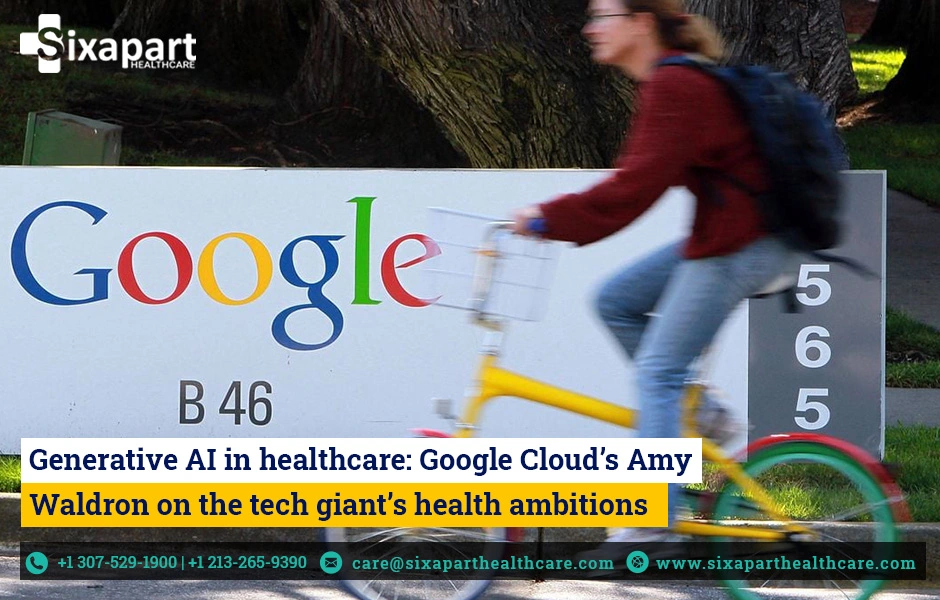Generative AI in healthcare: Google Cloud’s Amy Waldron on the tech giant’s health ambitions
Healthcare Dive caught up with Google Cloud’s Amy Waldron to discuss the technology giant’s plans — and the potential risks — for generative AI in healthcare.
Article By: Brian T. Horowitz
Blog Source From : https://www.healthcaredive.com/

Google has been keeping busy in the healthcare industry, announcing partnerships with organizations to implement generative artificial intelligence. The search giant announced partnerships this year with health systems like Mayo Clinic to use generative AI, or algorithms that can be used to create new content like text, to improve clinician workflows.

The company is also tackling billing, with financial engagement platform Cedar announcing an agreement with Google Cloud earlier this month to use its generative AI tools to help patients understand their healthcare bills.
Meanwhile, a Google Research tool trained specifically on medical data, called Med-PaLM 2, can pass medical license tests and may draft medical documentation in the future.
Healthcare Dive caught up with Amy Waldron, global director for healthcare and life sciences solutions, North America, at Google Cloud, to find out what these developments mean for the future of healthcare.
Editor’s note: This interview has been edited for clarity and brevity.
What will Google Health’s large language model (LLM) Med-PaLM mean for healthcare? Is Google concerned about stuttering uptake among providers concerning AI and LLM?
WALDRON: Med-PaLM is a large language model, but it’s designed to provide high-quality answers to medical questions. Med-PaLM 2 has been trained with a medical corpus, so it’s been tuned to the medical industry. To give you a perspective of the volume, there were 540 billion parameters that went into training Med-PaLM. So it’s been designed to encode medical knowledge, and to answer questions and summarize insights from a variety of medical texts.
We’re definitely not in a hurry to push something like this out without the confidence of industry experts and ourselves. And yes, we are on the extreme with regards to making sure that we have ethical use of AI. We also are in tight collaboration with our customers that are testing these pilots, because there’s a significant responsibility with this type of technology, especially in the clinical environment.
How will generative AI balance accuracy with risks when it comes to healthcare?
WALDRON: All of us have to make sure this stuff is meaningful, but also safe and used responsibly. No one wants to mess this up.
I think you have to be thoughtful with what information you include with your enterprise search capability, and customers have full control over what information is leveraged. And look at how you’re transforming that [search] experience by using conversational AI to be more like a conversation, versus a patient or consumer trying to look at many different sources to find the right answer.
That’s an example of very low risk, high reward. The same thing when you look at when clinicians have to search through healthcare payer policies. In many cases, they’re looking through tons of PDFs. Now with this technology, that enterprise search can give you the ability to search those PDFs, so when a clinician or someone on their team asks a question, that information can be served to them.
So there are quality controls. There are a lot of use cases in healthcare that make sense to start on where you can get those near-term benefits and not expose people to risk.
Google Cloud introduced its Claims Acceleration Suite in April. What feedback are you receiving from health plans, and how do you plan to grow the platform going forward? Why is prior authorization still such a big challenge for the healthcare industry and how can AI help solve it?
WALDRON: With Claims Acceleration Suite, that was a great example of how we streamlined the prior-authorization submission, the ingestive information and the decisioning. We use AI capabilities to make that process flow.
People are testing how to use generative AI to help clinicians draft prior authorization letters. It’s that drafting we can do with generative AI that we couldn’t do before.
With generative AI, creating communications that resonate with people is really important, and that’s something that is going to help with payer-provider communications. But it’s also going to be a tremendous asset to the communications that healthcare organizations are having with consumers.
How are health systems such as Mayo Clinic using Google Cloud to explore generative AI’s applications?
WALDRON: There are four broad categories from a healthcare perspective where we’re seeing AI and generative AI leveraged: The first one is administrative and operational efficiency. The second one is clinician and care team support. You also have patient and consumer engagement, and advancing research and development.
That clinician and care team support is where Mayo is definitely doubling down on technology. They’re using our Generative AI App Builder to improve the efficiency of clinical workflows. It’s a suite that has three major capabilities that healthcare customers are diving into. One is foundation models, but the other two are pretty deep: enterprise search and conversational AI.

